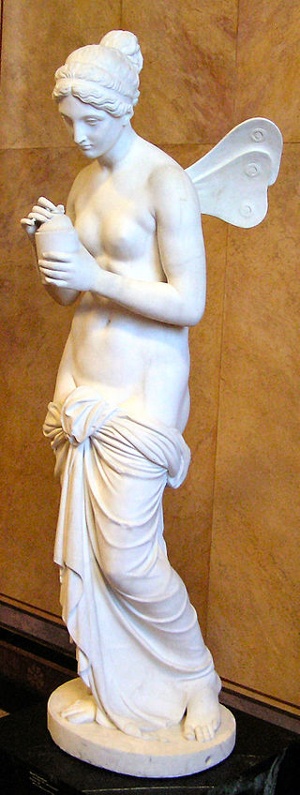John Keats, selected poems Contents
Ode to Psyche: Imagery, symbolism and themes
Imagery and symbolism in Ode to Psyche Gardens of the mindLightThemes in Ode to PsycheThe union of body and soul in loveThe development of creativityAn understanding of suffering
Imagery and symbolism in Ode to Psyche
Gardens of the mind
Keats is building a ‘sanctuary’ with ‘branched thoughts’ and ‘the wreath'd trellis of a working brain’. Gardens speak of the human cultivation of the riches of nature, of order brought to fecundity, which is an appropriate image of the poet’s work. Keats is marshalling a succession of impressions into a poetic narrative, building a verbal construct to honour the importance of the soul and love.
His ‘gardener Fancy’ indicates Keats’ belief in the powers of human invention. The human power to imagine and to create art is seen as something which aids and improves nature. The flowers ‘will never breed the same’ because the imagination is infinite and can create endlessly and without repetition.
Light
There are a number of references to light. The poem starts in gentle, woodland light and mentions of ‘eye-dawn’ and ‘aurorean’ convey the pink glow of increasing morning light. In waking to daylight, the mortal goddess Psyche outshines the moon goddess Phoebe and her associated stars. Referring to Vesper (the evening star of Venus) as a glow-worm is bathetic however (though this may be unintended).
The light associated with Psyche intensifies – in the third stanza she is ‘brightest’ and her wings are ‘lucent’ and by the end of the fourth verse she is associated with the warmth and light of a flaming ‘bright torch’. This conveys not only her mortal beginnings but also her union with the heat and life-giving force of erotic love.
Investigating imagery and symbolism in Ode to Psyche
- Compare the images associated with the forest landscape with those of the cultivated landscape created by the ‘gardener’ Fancy in the closing tableau. What are the differences in effect?
- How does Keats use images associated with the senses in this poem?
- Some critics have seen this ode as an extended metaphor about poetry. What evidence can you find for this reading?
Themes in Ode to Psyche
 The union of body and soul in love
The union of body and soul in love
As a mortal who becomes immortal, who has enjoyed physical sexual union that is also union with a god (Eros), Psyche symbolises for Keats the idea that true love involves both body and soul, both eternal and temporal values. Love aspires to last forever but is also fiercely of the here and now. It inhabits holy temples and hot bedrooms.
Keats humanises the goddess: her temple becomes the human mind. In the story told by Apuleius, Psyche met Eros in a darkened room; Keats will provide ‘A bright torch, and a casement ope at night,/To let the warm Love in!’
The development of creativity
Keats uses Psyche as a means of expressing his belief that the creative process involved in being a human being (especially in being a creative artist) entails an exploration of the ‘untrodden region[s] of [the] mind’.
For Keats being human meant cultivating one’s unconscious, using the imagination to make all the disparate experiences encountered in life cohere into a ‘rosy sanctuary’ which is as individual as the person who has had the experiences. It also means engaging with ‘pleasant pain’, a typically Keatsian oxymoron of finding riches within painful circumstances (rather than avoiding them). In a letter to George, dated April 1819, Keats wrote:
Do you see not how necessary a World of Pains and troubles is to school an Intelligence and make it a soul?
An understanding of suffering
Keats was not a Christian and so Christian faith in otherworldly rewards could no longer provide a justification for human suffering for him. As an alternative Keats turns to the glories of Hellenism with its mixture of nature and erotic love. Keats believes that it is vital for the artist to be open to both, from which he creates something beautiful and immortal, through the power of the human imagination.
Investigating themes in Ode to Psyche
- Some critics have seen this poem as an allegory of the human soul and Keats’ way of asserting that there is something godlike in the soul which has not been acknowledged until modern times. Do you think this interpretation works?
- To what extent are the themes in this poem typical of Keats in terms of their engagement with apparently contradictory feelings?
- To what extent is this poem dealing with the preoccupations of a creative artist?
Using descent from the sublime to the ridiculous for effect.
To represent a thing or idea by something else through an association of ideas.
A Figure of speech in which two apparently opposite words or ideas are put together as if they were in agreement.
Name originally given to disciples of Jesus by outsiders and gradually adopted by the Early Church.
To do with Greece and classical Greek culture. Translation: Hellas = Greece.
Recently Viewed
Related material
Scan and go
Scan on your mobile for direct link.